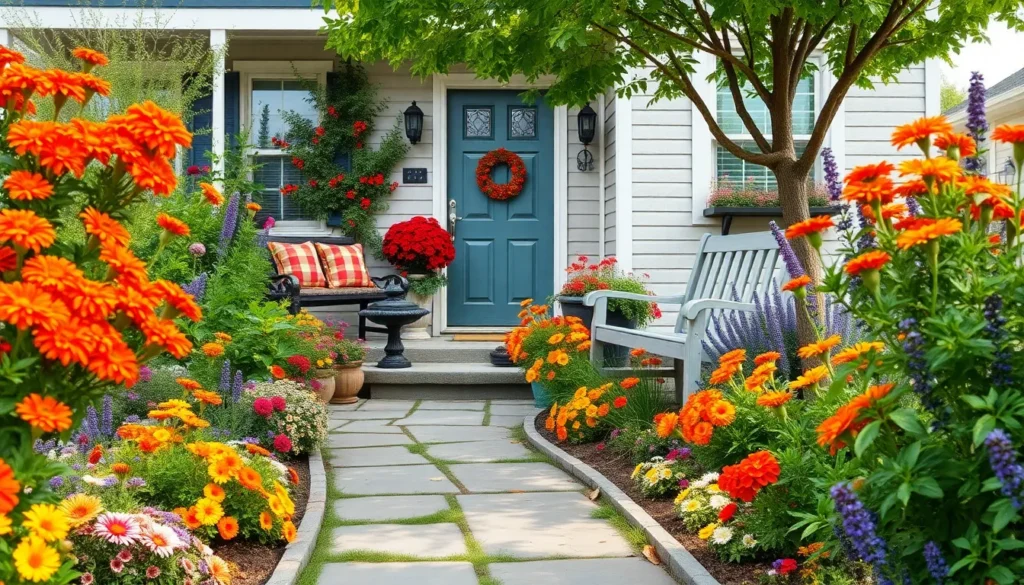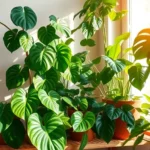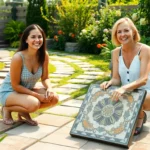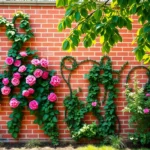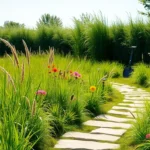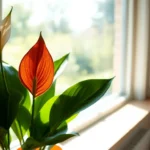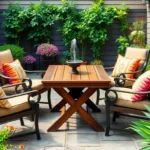Your front yard is the first thing guests see when they visit your home – and it’s your chance to make a stunning first impression. We’ve all walked past houses with gorgeous front gardens that made us stop and admire their beauty. That curb appeal doesn’t happen by accident.
Creating an eye-catching front garden doesn’t require a massive budget or professional landscaping skills. With the right combination of plants, design elements, and strategic planning, we can transform any front yard into a welcoming outdoor space that reflects your personal style.
Whether you’re working with a small urban plot or a sprawling suburban lawn, the possibilities are endless. From colorful flower beds and sculptural shrubs to charming walkways and seasonal displays, we’ll explore practical ideas that’ll boost your home’s value while creating a space you’ll love coming home to every day.
Create a Welcoming Entrance With Colorful Annual Flowers
Annual flowers offer the perfect solution for creating an instantly vibrant front garden that changes with your preferences each year. We can transform any entrance into a show stopping display using these versatile plants that bloom continuously throughout their growing season.
Choose Season-Long Blooming Varieties
Marigolds provide consistent color from spring until the first frost, making them one of our most reliable annual choices for front garden displays. These hardy flowers come in shades of yellow, orange, and deep red, requiring minimal maintenance while delivering maximum visual impact. Petunias offer another excellent option, blooming continuously for months with proper deadheading and regular watering.
Impatiens work wonderfully in partially shaded front garden areas where other annuals might struggle to perform. We recommend New Guinea impatiens for their larger flowers and tolerance to more sun exposure than traditional varieties. Begonias complement impatiens perfectly, providing waxy blooms in pink, red, white, and coral that thrive in similar growing conditions.
Zinnias deliver bold statement colors in front garden beds, attracting butterflies while requiring very little care once established. These drought tolerant annuals bloom in virtually every color except blue, giving us endless possibilities for creating eye catching combinations that last until hard frost arrives.
Plant in Complementary Color Schemes
Monochromatic plantings create sophisticated front garden displays using different shades of the same color family for maximum visual cohesion. We can plant white alyssum with white petunias and white impatiens to create an elegant, unified entrance that looks professionally designed. Purple schemes work equally well, combining purple petunias with lavender ageratum and deep purple coleus for foliage contrast.
Analogous color combinations use colors that sit next to each other on the color wheel for harmonious front garden plantings that feel naturally balanced. Yellow marigolds paired with orange nasturtiums and red salvia create a warm, welcoming entrance that draws visitors toward your home. Cool combinations like blue lobelia with purple petunias and white alyssum offer a calming, sophisticated alternative.
Complementary colors create vibrant contrast in front garden beds by pairing colors directly across from each other on the color wheel. Orange marigolds with blue ageratum create stunning visual pop, while yellow coreopsis combined with purple verbena delivers equally dramatic results that photograph beautifully.
Use Container Gardens for Flexibility
Large planters flanking your front entrance create symmetrical focal points that can be replanted seasonally to match changing preferences or color schemes. We recommend using containers at least 18 inches wide to provide adequate root space for multiple annual varieties while maintaining proper proportions with your home’s architecture.
Tiered container arrangements add vertical interest to front garden spaces without requiring permanent industry changes. Stack different sized pots or use plant stands to create layered displays featuring trailing petunias in upper containers and upright marigolds or zinnias in lower planters for ever-changing visual appeal.
Window boxes and hanging baskets extend your annual flower display to previously unused vertical spaces around your front entrance. Trailing varieties like bacopa, lobelia, and trailing petunias work perfectly in these elevated containers, creating cascading color that softens architectural lines while adding charm to any front garden design.
Design Eye-Catching Pathways Using Natural Materials
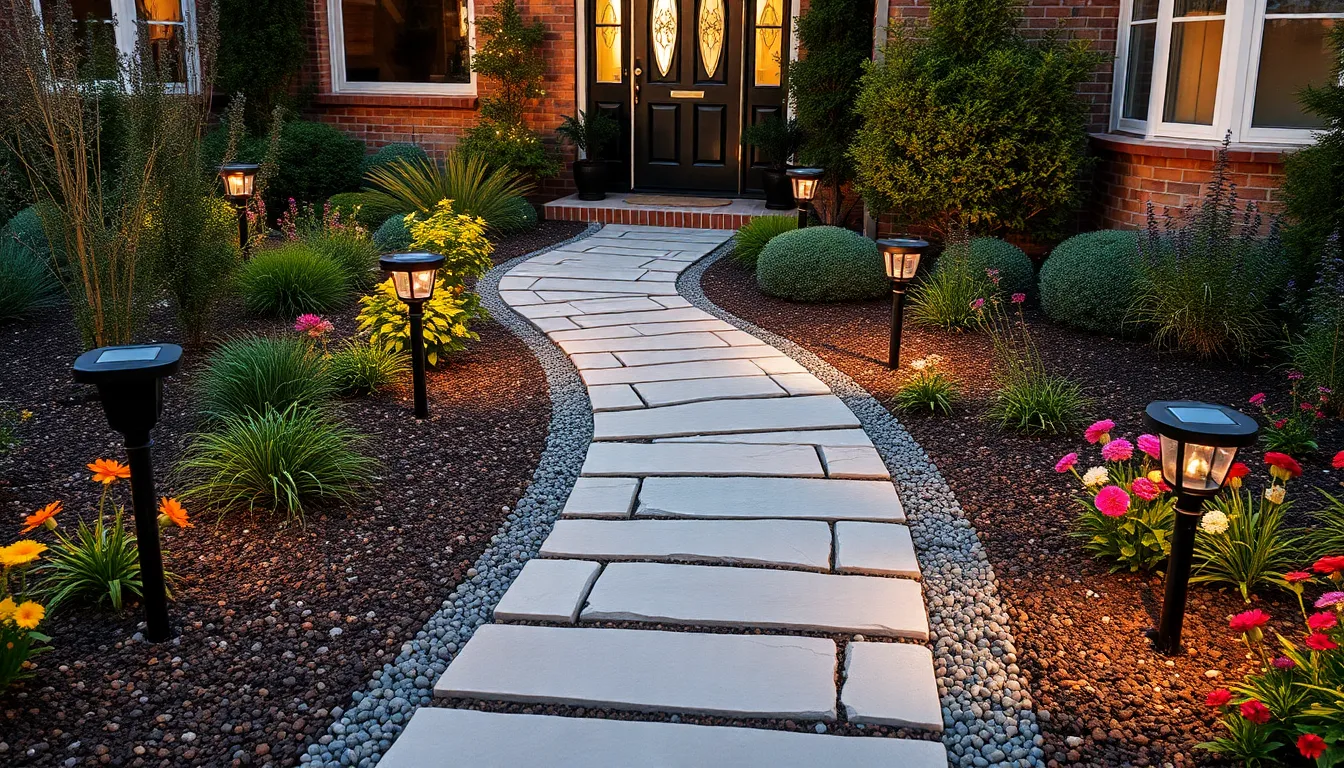
Building on your colorful entrance displays, we can create structured pathways that guide visitors beautifully toward your front door while adding architectural interest to your garden design.
Install Stepping Stone Walkways
Stepping stone pathways offer an elegant solution that transforms ordinary walkways into garden features themselves. Natural stone materials like slate, limestone, or sandstone create durable surfaces that withstand weather while maintaining their visual appeal for years. We recommend spacing stones 18 to 24 inches apart to accommodate comfortable walking strides for most adults.
Brick stepping stones provide a classic alternative that complements traditional home styles perfectly. These materials can be arranged in various patterns like herringbone or running bond to add visual texture. Installing them requires minimal excavation since you’ll only need to level small areas rather than preparing an entire pathway surface.
Creative arrangements work best when you consider the natural flow of foot traffic from your street to your entrance. Curved pathways feel more organic and interesting than straight lines while allowing you to showcase different garden areas along the route.
Create Gravel or Mulch Borders
Gravel borders deliver excellent drainage properties while creating clean lines that define your pathway edges effectively. River rock gravel in neutral tones like gray or tan complements most home exteriors without competing with your plantings. We suggest using gravel pieces between 3/8 and 3/4 inches for optimal walking comfort and visual appeal.
Organic mulch borders using wood chips or shredded bark provide natural color variation that changes beautifully throughout seasons. These materials help retain soil moisture around pathway plantings while suppressing weed growth that could otherwise spoil your carefully designed borders. Cedar and pine bark mulches last longer than hardwood options and resist fading from sun exposure.
Maintenance benefits make both options practical choices for busy homeowners. Gravel requires occasional raking to maintain its appearance while mulch needs annual refreshing to keep borders looking fresh and vibrant.
Add Solar Lighting for Evening Appeal
Solar path lights create warm ambiance that extends your garden’s beauty into evening hours without increasing electricity costs. Modern LED solar fixtures provide 6 to 8 hours of illumination after full daylight charging and require no wiring installation. We recommend spacing lights every 6 to 8 feet along pathways for optimal visibility and safety.
Solar spot lights highlight exact garden features like unique plantings, decorative stones, or architectural elements that deserve attention after dark. These focused fixtures can be easily repositioned as your garden evolves or seasonal displays change throughout the year.
Energy efficiency makes solar lighting an environmentally conscious choice that reduces ongoing maintenance since there are no electrical connections to weatherproof or bulbs to replace frequently.
Incorporate Low-Maintenance Perennial Plants for Year-Round Beauty
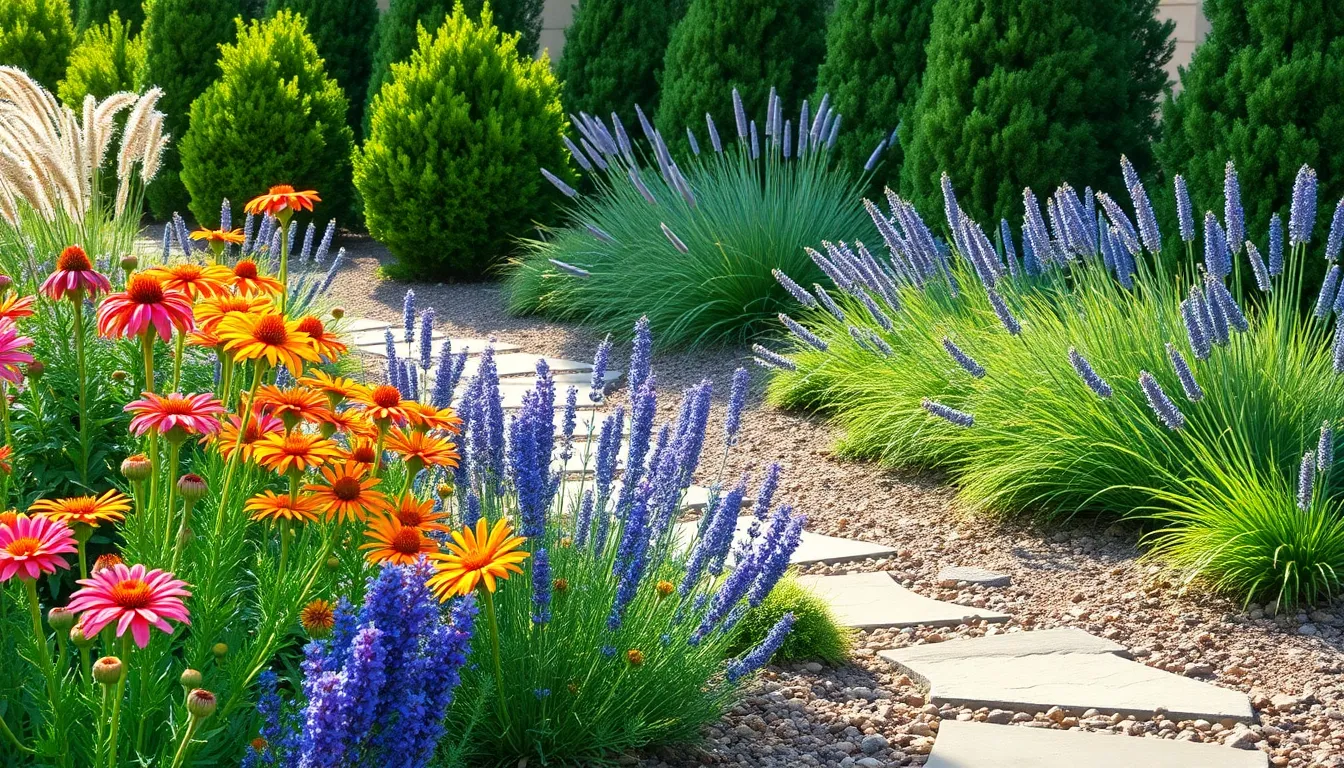
Building on the foundation of colorful annuals and well-designed pathways, we can create lasting impact with perennial plants that return year after year. These strategic plant choices reduce maintenance while providing continuous beauty across all seasons.
Select Native Plants for Your Climate Zone
Choosing plants native to our region ensures they’re naturally adapted to local growing conditions and require minimal intervention. Native coneflowers thrive in temperate zones with their vibrant purple, pink, and white blooms that attract beneficial pollinators throughout summer. Succulents excel in arid climates, offering sculptural forms and unique textures that complement modern front yard designs.
We recommend researching our exact hardiness zone before making plant selections to guarantee optimal performance. Local extension offices provide comprehensive lists of native species that flourish in our area’s soil types, rainfall patterns, and temperature ranges. Established native plants typically require 50% less water than non-native varieties once their root systems mature.
Choose Drought-Tolerant Options
Selecting drought-tolerant perennials creates resilient front gardens that maintain their beauty during dry spells and water restrictions. Lavender provides fragrant purple flowers and silvery foliage that thrives with minimal irrigation while deterring pests naturally. Sedum varieties offer succulent leaves and late-season blooms in shades of pink, red, and yellow that require virtually no supplemental watering.
Yucca plants deliver dramatic architectural elements with their sword-like leaves and towering flower spikes that can reach 6 feet tall. These xerophytic plants store water in their tissues, making them perfect for slopes, rock gardens, and areas with poor drainage. Efficient drip irrigation systems can support these plants during establishment while using 30-50% less water than traditional sprinkler methods.
Plan for Seasonal Interest and Texture
Creating layered plantings with trees, shrubs, perennials, and groundcovers ensures our front gardens remain visually captivating throughout every season. Daylilies provide grass-like foliage and abundant flowers from spring through fall, with different varieties extending the blooming period for months. Ornamental grasses add movement and texture while providing winter interest with their dried seed heads and golden autumn colors.
We can enhance visual appeal by incorporating textural elements like natural stone borders, brick pathways, and decorative mulches that complement our plant selections. Evergreen shrubs provide structure and winter color, while deciduous perennials offer seasonal changes that keep the industry ever-changing. Strategic placement of plants with varying heights, leaf shapes, and blooming times creates depth and prevents monotonous appearance during any single season.
Add Architectural Elements With Decorative Structures

Architectural features transform your front garden from a simple planting area into a sophisticated industry design. These structural elements create focal points that guide the eye and establish clear boundaries throughout your outdoor space.
Install Arbors or Garden Arches
Arbors create a stunning entrance that frames your front door while adding vertical interest to your garden design. We recommend choosing vine-covered structures that blend seamlessly with your home’s architectural style and provide natural beauty throughout growing seasons.
Position garden arches strategically along pathways to create inviting transitions between different garden areas. These elegant structures work particularly well when covered with climbing roses, clematis, or honeysuckle that adds seasonal color and fragrance.
Select materials that complement your home’s exterior, such as cedar wood for rustic appeal or wrought iron for traditional elegance. Proper installation ensures these features withstand weather conditions while maintaining their welcoming atmosphere for years.
Create Raised Garden Beds
Build raised beds using natural stone to add depth and visual dimension to your front yard industry. These elevated planting areas help define exact garden zones while providing better drainage and soil control for your plants.
Choose wood construction for a more budget-friendly option that still delivers professional results. Cedar and redwood offer natural resistance to decay and insects, making them ideal materials for long-lasting raised bed structures.
Design multiple levels to create terraced effects that work especially well on sloped properties. This approach maximizes planting space while adding architectural interest that draws attention to your carefully selected plant combinations.
Incorporate built-in seating along raised bed edges to create functional garden elements that serve dual purposes. This design strategy adds convenience while maintaining the clean, organized appearance that raised beds provide.
Use Decorative Fencing or Borders
Install wooden picket fences to establish charming boundaries that complement cottage-style garden designs. These classic structures define your garden’s perimeter while adding traditional appeal that enhances your home’s curb appeal.
Consider metal trellises for properties requiring more elegant answers that support climbing plants. These decorative elements provide structure for vertical gardening while maintaining an open, airy feel in your front yard space.
Add brick borders to create permanent edging that separates lawn areas from planted beds. This timeless option requires minimal maintenance while providing clean lines that give your garden a polished, professional appearance.
Choose materials that match your home’s existing architectural features to ensure cohesive design throughout your property. Coordinating colors and textures between fencing elements and your house creates visual harmony that increases overall property value.
Enhance Curb Appeal With Strategic Tree and Shrub Placement
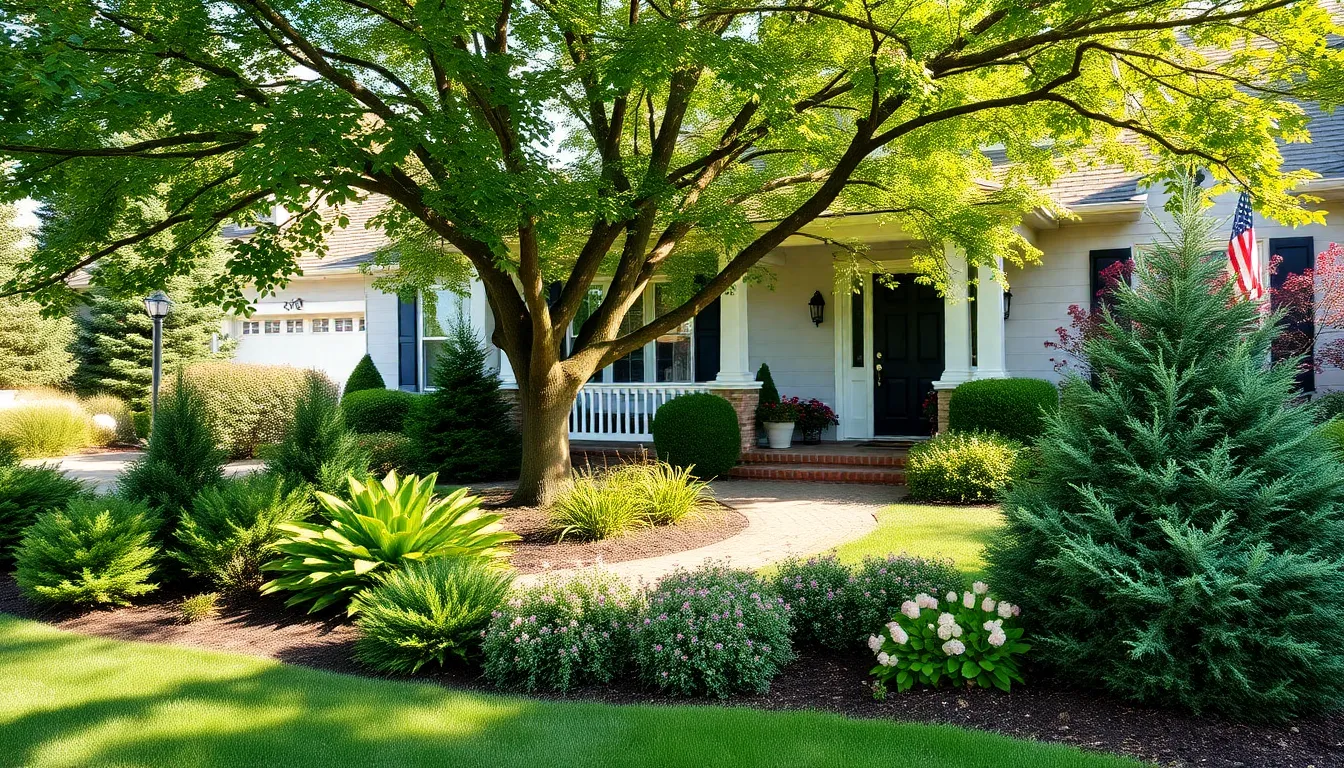
Strategic placement of trees and shrubs creates the foundation for an impressive front yard industry that transforms your home’s exterior appeal. Layering plants with different heights and textures adds visual depth while establishing a cohesive design framework.
Plant Foundation Shrubs Near the House
Foundation shrubs serve as the connecting element between your home’s architecture and the surrounding industry. Planting these essential elements near your house foundation creates a polished, finished appearance that frames your home beautifully. We recommend selecting shrubs that complement your home’s style and scale, ensuring they won’t outgrow their designated space over time.
Choose evergreen varieties like boxwood or holly for year-round structure, or mix in flowering shrubs such as hydrangeas and azaleas for seasonal color bursts. Position taller shrubs at corners and under windows, with shorter varieties filling spaces between to create a natural flow. This thoughtful arrangement prevents your home from appearing to sit directly on the ground while adding valuable curb appeal.
Add Shade Trees for Long-Term Value
Shade trees represent one of the most valuable investments you can make in your front yard landscaping. These magnificent additions provide immediate visual impact while offering substantial long-term benefits including energy savings and increased property value. Mature trees create natural focal points that anchor your entire industry design.
Select species appropriate for your climate zone and available space, considering factors like mature size, growth rate, and seasonal characteristics. Maple, oak, and elm trees offer excellent shade coverage and stunning fall colors, while flowering varieties like dogwood or cherry trees provide spring blooms. Plant shade trees at least 15-20 feet from your house to allow for proper root development and prevent future foundation issues.
Create Privacy Screens With Evergreen Options
Evergreen privacy screens offer year-round screening answers that maintain their effectiveness through all seasons. These living barriers block unwanted views while creating intimate outdoor spaces that feel secluded and peaceful. Arborvitae and boxwood represent excellent choices for privacy screening because they maintain dense foliage throughout the year.
Design your privacy screen by planting evergreens in staggered rows for maximum coverage, spacing them according to their mature width requirements. Consider varying heights within your screen to create visual interest rather than a uniform wall effect. Fast-growing options like Leyland cypress provide quick results, while slower-growing varieties like yew offer denser, more refined screening over time.
Maximize Small Spaces With Vertical Gardening Solutions
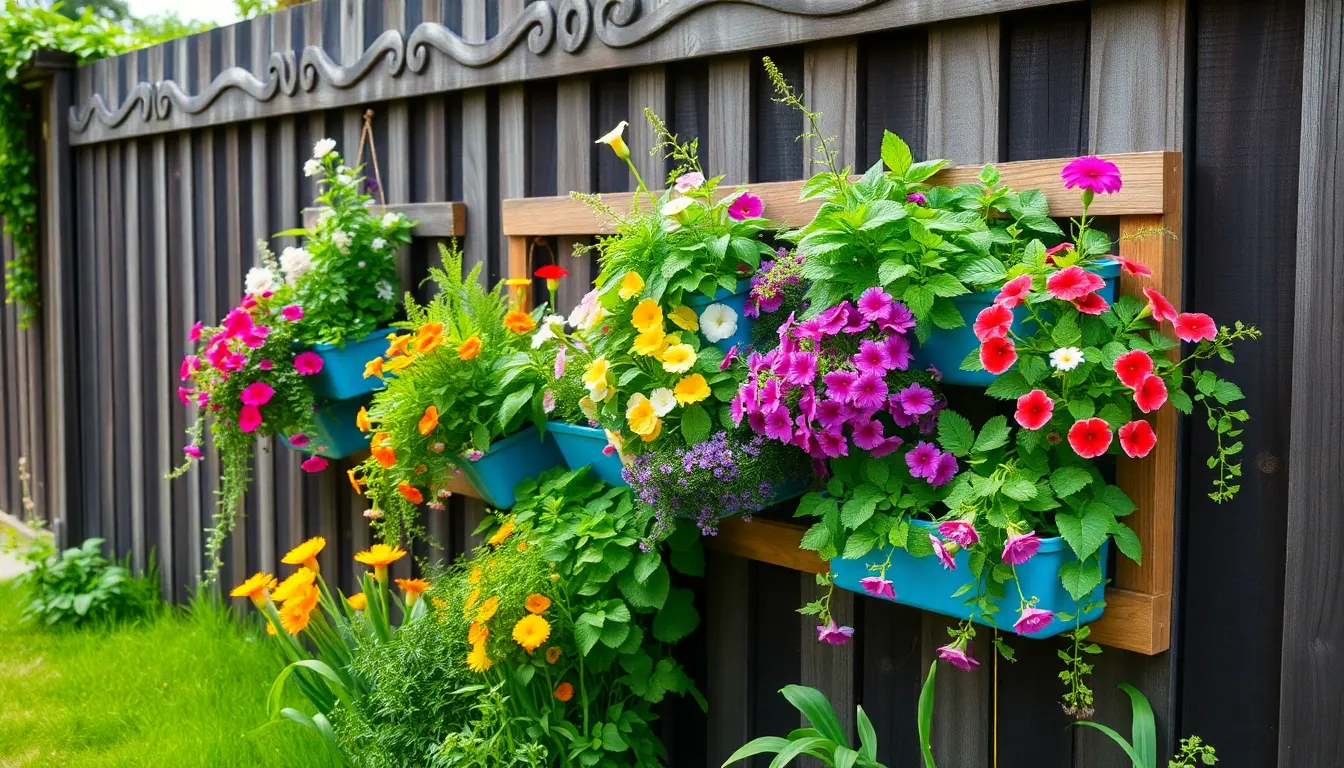
We can transform even the smallest front yard areas into stunning garden displays by thinking upward instead of outward. Vertical gardening answers offer practical ways to maximize planting opportunities while creating impressive visual impact without requiring extensive ground space.
Install Wall-Mounted Planters
Wall-mounted planters give us the ability to cultivate flowers, herbs, and small shrubs directly on vertical surfaces such as fences or exterior walls. This method saves valuable ground space while bringing greenery closer to eye level, improving curb appeal and providing easy access for maintenance. We can mount these planters on brick walls, wooden fences, or siding to create living walls that add color and texture to previously unused vertical spaces. Popular options include pocket planters for cascading flowers, box planters for herbs like basil and thyme, and individual containers for statement plants like small boxwood shrubs.
Use Trellises for Climbing Plants
Trellises support vining plants like roses, clematis, ivy, or beans, creating height and structure without consuming important ground area. We can place them against walls, fences, or freestanding in garden beds to soften hardscapes and add privacy. These vertical supports allow climbing roses to create romantic focal points, while clematis vines produce stunning seasonal blooms that draw the eye upward. Bean plants and morning glories offer quick growing options for immediate coverage, and ivy provides year round greenery that can transform plain walls into living backdrops.
Create Tiered Garden Displays
Tiered arrangements involve stacking planters or creating multiple planting levels, making them ideal for limited front yard areas. This approach provides visual depth, allows for diverse plant combinations, and makes watering and maintenance more efficient. We can use terraces or step like structures for sloped front yards, offering multiple landscaping levels while helping control erosion. Three tier plant stands showcase different flowering plants at varying heights, while cascading arrangements create waterfall effects with trailing petunias and ivy. Stone or wooden steps can incorporate built in planting pockets for herbs and small perennials.
Establish Focal Points Using Water Features and Garden Art
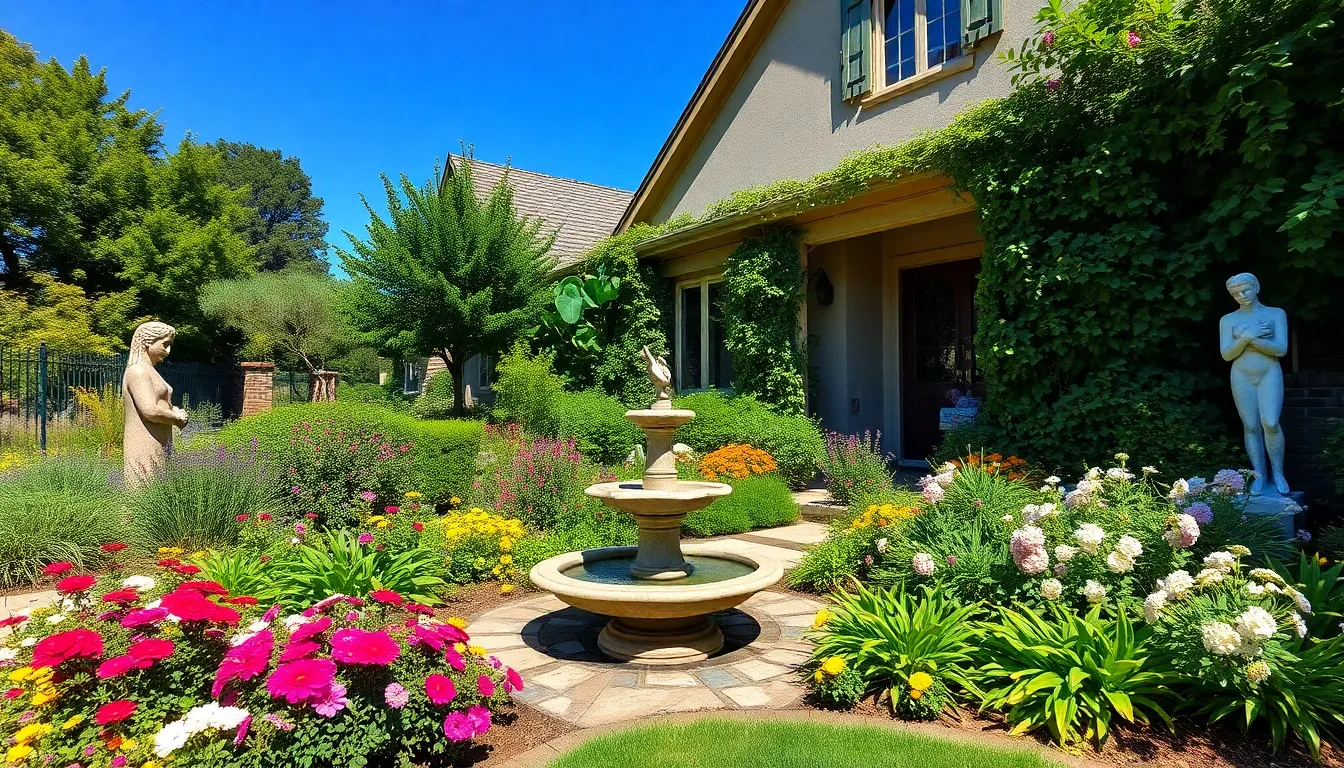
Building on our vertical gardening answers, we’ll now explore how strategic focal points can transform your front garden into a captivating display. Water features and garden art create visual anchors that draw the eye and add personality to your outdoor space.
Add Small Fountains or Birdbaths
Small fountains serve as enchanting centerpieces that bring both visual appeal and soothing sounds to your front garden. We recommend choosing compact fountain designs that fit your space without overwhelming other elements. Tabletop fountains work perfectly for smaller areas, while tiered stone fountains create dramatic statements in larger gardens.
Birdbaths attract wildlife while serving as elegant focal points throughout the year. Position these features near flowering plants to create natural gathering spots for birds and butterflies. Solar powered birdbaths eliminate the need for electrical connections and provide gentle water circulation that keeps the water fresh. Maintenance remains minimal since most modern birdbaths require only weekly cleaning and seasonal water changes.
Location matters significantly when installing water features in front gardens. Place fountains or birdbaths where they’re visible from your home’s entrance and main windows. These strategic positions allow you to enjoy the features from both inside and outside your home while creating welcoming focal points for visitors.
Display Sculptural Elements
Sculptural elements add artistic flair and personal character to front garden spaces. We suggest selecting pieces that complement your home’s architectural style rather than competing with it. Classic garden statues work beautifully with traditional homes, while modern abstract sculptures enhance contemporary designs.
Scale plays a crucial role in choosing the right garden art for your space. Larger sculptures command attention as primary focal points, while smaller pieces work best when grouped together or positioned near plantings. Metal sculptures develop attractive patina over time, while stone pieces provide timeless elegance that weathers gracefully through seasons.
Placement strategies maximize the impact of your sculptural investments. Position statement pieces at pathway intersections or garden bed corners where they naturally draw attention. Create vignettes by surrounding sculptures with complementary plants that enhance rather than hide the artistic elements. Lighting these features extends their visual impact into evening hours.
Create Seasonal Decoration Spots
Seasonal decoration spots keep your front garden fresh and captivating throughout the year. We recommend designating exact areas where you can easily swap out decorative elements as seasons change. These flexible zones allow you to celebrate holidays and seasonal transitions without major garden redesigns.
Container arrangements provide the perfect foundation for seasonal displays. Large planters positioned near your entrance can showcase autumn mums, winter evergreen arrangements, spring tulips, or summer annuals. This approach lets you maintain year round color while adapting to seasonal themes and weather conditions.
Seasonal plant rotations ensure continuous visual interest in your front garden spaces. Spring bulbs give way to summer perennials, which transition into fall foliage displays before winter structural elements take center stage. Planning these transitions in advance helps you maintain a cohesive look while embracing seasonal variety that keeps neighbors and visitors engaged with your garden’s evolving beauty.
Design Functional Seating Areas for Outdoor Relaxation
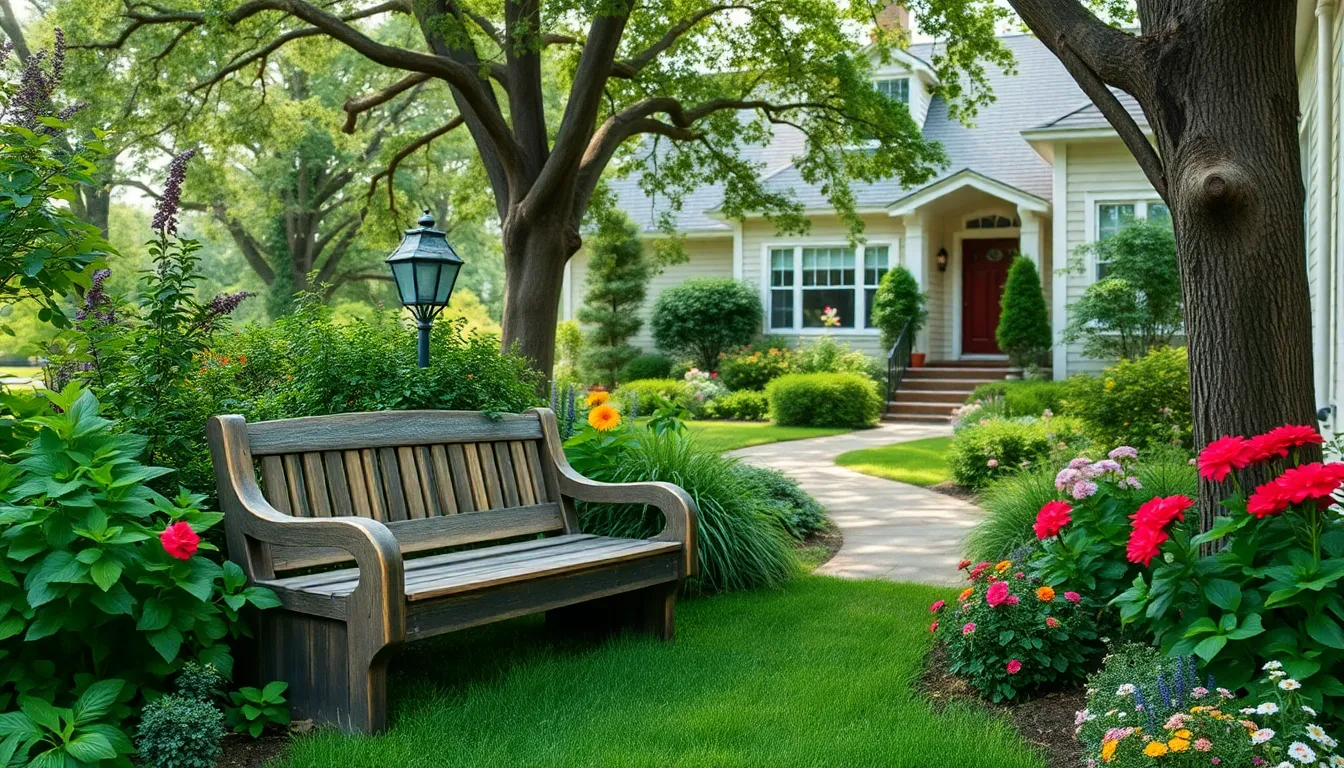
Creating comfortable seating areas transforms your front garden from a purely visual display into a functional outdoor living space. We’ll explore strategic placement options that encourage relaxation while improving your garden’s overall appeal.
Install Garden Benches Along Pathways
Installing garden benches along pathways creates natural rest stops that encourage visitors to linger and appreciate your garden’s beauty. Weather resistant materials like wood or metal ensure durability against seasonal changes while maintaining their aesthetic appeal for years.
Strategic placement matters when positioning benches along garden walkways. We recommend spacing them at natural viewing points where guests can enjoy the best garden vistas or architectural features of your home. Classic wooden benches complement traditional garden styles, while sleek metal options suit contemporary landscapes perfectly.
Consider the pathway’s width when selecting bench sizes to maintain comfortable traffic flow. Built in storage benches offer dual functionality by providing seating while concealing garden tools or seasonal decorations underneath. Regular maintenance keeps these pathway benches looking their best throughout changing seasons.
Create Cozy Corner Nooks
Creating cozy corner nooks transforms underutilized garden spaces into intimate retreats perfect for morning coffee or evening relaxation. Designating a quiet corner with comfortable seating arrangements establishes a sense of privacy within your front garden industry.
Privacy elements enhance the secluded feeling of corner seating areas significantly. Adding plants or installing a trellis around your nook creates natural boundaries that screen the area from street view. Climbing vines on trellises provide seasonal interest while establishing the intimate atmosphere you’re seeking.
Comfort features make corner nooks more inviting for extended relaxation periods. We suggest incorporating soft cushions, small side tables, and even outdoor rugs to create a living room feeling outdoors. Nearby container gardens add color and fragrance while maintaining the cozy atmosphere throughout different seasons.
Add Weather Resistant Furniture Options
Adding weather resistant furniture options provides flexible seating answers that withstand various weather conditions without compromising style or comfort. Wicker chairs and recycled plastic sets offer excellent durability while requiring minimal maintenance throughout the year.
Material selection impacts both longevity and maintenance requirements of outdoor furniture pieces. Aluminum frames resist rust and corrosion, while synthetic wicker maintains its appearance without fading or cracking. Recycled plastic furniture comes in many colors and styles while being completely weatherproof and environmentally conscious.
Arrangement flexibility allows you to adapt seating configurations for different occasions and seasons. Lightweight pieces can be easily repositioned to take advantage of shade during summer or capture warming sunlight during cooler months. Stackable options provide convenient storage during harsh weather while maintaining their attractive appearance when in use.
Conclusion
Creating a stunning front garden doesn’t require a massive budget or professional expertise. With thoughtful planning and the right combination of colorful plants seasonal elements and strategic design choices we can transform any outdoor space into an inviting entrance that reflects our personal style.
From drought-tolerant perennials to eye-catching pathways and functional seating areas each element works together to enhance our home’s curb appeal. The key lies in selecting features that complement our lifestyle and local climate while maintaining visual interest throughout the seasons.
Whether we’re working with a sprawling lawn or a compact urban space these practical ideas help us maximize our front yard’s potential. By implementing even a few of these strategies we’ll create a welcoming atmosphere that not only impresses visitors but also increases our property value for years to come.
Frequently Asked Questions
What are the best annual flowers for creating vibrant front yard curb appeal?
Marigolds, petunias, impatiens, and zinnias are excellent choices for season-long blooming. These flowers offer vibrant colors, require minimal maintenance, and provide continuous visual impact throughout the growing season. Plant them in complementary color schemes like monochromatic or analogous combinations for the most cohesive and inviting appearance.
How can I create attractive pathways without breaking my budget?
Use natural materials like stepping stones, classic brick, or gravel borders to design eye-catching walkways. Arrange stones in creative patterns for visual texture, and define edges with gravel for drainage or mulch for seasonal color variation. These materials are affordable and add architectural interest while guiding visitors to your front door.
What are the best low-maintenance plants for year-round beauty?
Choose native perennial plants like coneflowers, along with drought-tolerant options such as lavender, sedum, and yucca. Succulents are also excellent choices as they require minimal water and intervention. These plants thrive in local climates and maintain their beauty even during dry spells, reducing maintenance time and costs.
How can I maximize planting space in a small front yard?
Utilize vertical gardening solutions like wall-mounted planters, trellises for climbing plants, and tiered garden displays. Container gardens with large planters, hanging baskets, and window boxes also maximize space efficiently. These approaches allow you to create stunning displays while saving valuable ground space in compact areas.
What architectural elements can enhance my front garden design?
Install arbors or garden arches for stunning entrances, add raised garden beds for better drainage and defined zones, and incorporate decorative fencing or borders. These elements create structure and visual interest while complementing your home’s architectural features. Built-in seating can also add functionality to raised beds.
How do I choose the right trees and shrubs for curb appeal?
Select foundation shrubs that complement your home’s style and scale, with evergreen options providing year-round structure. Choose shade trees appropriate for your climate and available space for immediate visual impact. Consider evergreen privacy screens with staggered planting for maximum coverage and visual interest throughout the seasons.
What focal points work best for front garden displays?
Add small fountains or birdbaths as enchanting centerpieces that attract wildlife and create visual interest. Incorporate sculptural elements that complement your home’s architectural style, paying attention to proper scale and strategic placement. Create seasonal decoration spots with container arrangements for year-round color rotation and maintained visual appeal.
How can I create functional seating areas in my front yard?
Install weather-resistant garden benches along pathways for natural rest stops, considering built-in storage options for added functionality. Create cozy corner nooks enhanced with plants or trellises for privacy. Choose flexible, weather-resistant furniture that can adapt to various occasions while maintaining style and comfort throughout different seasons.

